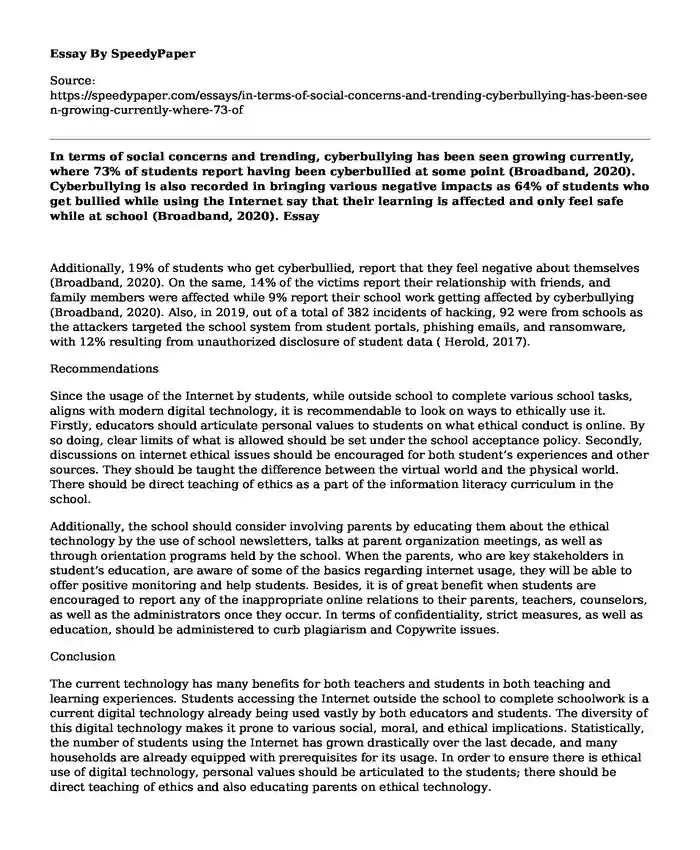
| Type of paper: | Essay |
| Categories: | Health and Social Care Business Nursing Ethics |
| Pages: | 2 |
| Wordcount: | 499 words |
Additionally, 19% of students who get cyberbullied, report that they feel negative about themselves (Broadband, 2020). On the same, 14% of the victims report their relationship with friends, and family members were affected while 9% report their school work getting affected by cyberbullying (Broadband, 2020). Also, in 2019, out of a total of 382 incidents of hacking, 92 were from schools as the attackers targeted the school system from student portals, phishing emails, and ransomware, with 12% resulting from unauthorized disclosure of student data ( Herold, 2017).
Recommendations
Since the usage of the Internet by students, while outside school to complete various school tasks, aligns with modern digital technology, it is recommendable to look on ways to ethically use it. Firstly, educators should articulate personal values to students on what ethical conduct is online. By so doing, clear limits of what is allowed should be set under the school acceptance policy. Secondly, discussions on internet ethical issues should be encouraged for both student's experiences and other sources. They should be taught the difference between the virtual world and the physical world. There should be direct teaching of ethics as a part of the information literacy curriculum in the school.
Additionally, the school should consider involving parents by educating them about the ethical technology by the use of school newsletters, talks at parent organization meetings, as well as through orientation programs held by the school. When the parents, who are key stakeholders in student's education, are aware of some of the basics regarding internet usage, they will be able to offer positive monitoring and help students. Besides, it is of great benefit when students are encouraged to report any of the inappropriate online relations to their parents, teachers, counselors, as well as the administrators once they occur. In terms of confidentiality, strict measures, as well as education, should be administered to curb plagiarism and Copywrite issues.
Conclusion
The current technology has many benefits for both teachers and students in both teaching and learning experiences. Students accessing the Internet outside the school to complete schoolwork is a current digital technology already being used vastly by both educators and students. The diversity of this digital technology makes it prone to various social, moral, and ethical implications. Statistically, the number of students using the Internet has grown drastically over the last decade, and many households are already equipped with prerequisites for its usage. In order to ensure there is ethical use of digital technology, personal values should be articulated to the students; there should be direct teaching of ethics and also educating parents on ethical technology.
References
Broadband. (2020). Critical Cyberbullying Statistics in 2020.
https://www.broadbandsearch.net/blog/cyber-bullying-statisticsHerold, B. (2017). New survey data show IT leaders underestimate cybersecurity challenges.
https://www.edweek.org/ew/articles/2017/11/29/schools-struggle-to-keep-pace-with-hackings.htmlLawson, F.(2020). Ethics and Technology Use in Education.
http://ethicsandtechnologyuseineducation.blogspot.com/NCES. (2018). Student Access to Digital Learning Resources Outside of the Classroom. National Center for Education Statistics.
https://nces.ed.gov/pubs2017/2017098/index.aspNCES. (2019). Percentage of children ages 3 to 18 who use the Internet from home, by selected child and family characteristics.
https://nces.ed.gov/programs/digest/d18/tables/dt18_702.15.asp?current=yes
Cite this page
In terms of social concerns and trending, cyberbullying has been seen growing currently, where 73% of students report having been cyberbullied at some point (Broadband, 2020). Cyberbullying is also recorded in bringing various negative impacts as 64% of students who get bullied while using the Internet say that their learning is affected and only feel safe while at school (Broadband, 2020).. (2023, Aug 15). Retrieved from https://speedypaper.net/essays/in-terms-of-social-concerns-and-trending-cyberbullying-has-been-seen-growing-currently-where-73-of
Request Removal
If you are the original author of this essay and no longer wish to have it published on the SpeedyPaper website, please click below to request its removal:
- Free Essay on Millon Clinical Multiaxial Instrument III
- Free Essay Example on Hoarding Behavior
- Essay Example on Clinical Supervision Model
- Essay Sample: An Economic Evaluation of Vaccination Programs
- Paper Example on Case Management and Health Care Reform
- Health Informatics: Future of Healthcare Delivery - Essay Sample
- Paper Example on Homeostasis
Popular categories




